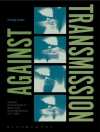Mexican cinema is booming today, a decade after the international
successes of Amores perros and Y tu mamá también. Mexican
films now display a wider range than any comparable country, from
art films to popular genre movies, and boasting internationally
renowned directors like Alfonso Cuarón, Alejandro
González Iñárritu, and Guillermo del Toro. At the
same time, television has broadened its output, moving beyond
telenovelas to produce higher-value series and mini-series. Mexican
TV now stakes a claim to being the most dynamic and pervasive
national narrative.
This new book by Paul Julian Smith is the first to examine the
flourishing of audiovisual fiction in Mexico since 2000,
considering cinema and TV together. It covers much material
previously unexplored and engages with emerging themes, including
violence, youth culture, and film festivals. The book includes
reviews of ten films released between 2001 and 2012 by directors
who are both established (Maryse Sistach, Carlos Reygadas) and new
(Jorge Michel Grau, Michael Rowe, Paula Markovitch). There is also
an appendix that includes interviews carried out by the author in
2012 with five audiovisual professionals: a feature director, a
festival director, an exhibitor, a producer, and a TV
screenwriter.
Mexican Screen Fiction will be an invaluable resource for
students and scholars and essential reading for anyone interested
in one of the most vibrant audiovisual industries in the world
today.
Jadual kandungan
Figures vii
Preface viii
Introduction: Mexican Screen Fiction 1
Jump Cut 1: Y tu mamá también 7
PART I SETTING SCENES 13
1 Revising Mexican Cinema 15
2 Following Festivals 30
Jump Cut 2: Perfume de violetas, Frida 47
PART II AUTEURS AND GENRES 53
3 A Case Study in Transnational Gay Auteurism:
Julián Hernández’s A Thousand Clouds of
Peace Encircle the Sky, Love, Your Being Love Will Never End
55
4 A Case Study in Genre and Nationality: Guillermo del
Toro’s Pan’s Labyrinth 64
Jump Cut 3: 21 Grams, Battle in Heaven, KM 31 78
PART III MARGINAL SUBJECTS 87
5 Youth Culture in Mexico: Rebel, I’m Gonna Explode
89
6 Lady Killers in TV Fiction: Women Murderers, The Aparicio
Women 120
Jump Cut 4: We Are What We Are, Leap Year 152
PART IV TALES OF INSECURITY 159
7 Film Fictions of Violence: Hell, Saving Private
Pérez, Miss Bala 161
8 TV Histories of Violence: In the Sewers, Cries of Death and
Freedom 191
Jump Cut 5: The Prize, Windows to the Sea 220
Conclusion: Between Cinema and Television 224
Appendix: Interviews with Five Media Professionals
(Jesús Mario Lozano, Daniela Michel, Alejandro Ramírez,
Roberto Fiesco, Leticia López Margalli) 227
Bibliography 256
Index 266
Mengenai Pengarang
Paul Julian Smith is Distinguished Professor in the Hispanic and Luso-Brazilian Program at the Graduate Center in City University of New York.












